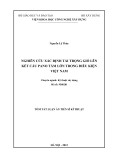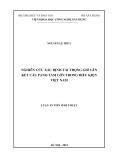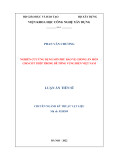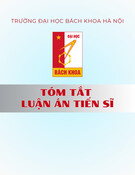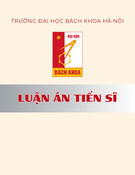
1
MINISTER OF EDUCATION AND TRAINING
UNIVERSITY OF TRANSPORT AND COMMUNICATIONS
NGO CHAU PHUONG
ANALYSIS OF INFLUENCING PARAMETERS AND BASICS
OF DETERMINING RESISTANCE FACTORS OF DRILLED
SHAFTS USED IN BRIDGE SUBSTRUCTURES IN HO-CHI-
MINH CITY
MAJOR: BRIDGE AND TUNNEL ENGINEERING
CODE: 62.58.02.05.03
BRIEF SUMMARY OF ENGINEERING DOCTORAL
THESIS
Hanoi-2014

2
This thesis completed at: Faculty of Civil Engineering
University of Transport and Communications
SUPERVISORS:
1. Assoc.Prof. Dr. Tran Duc Nhiem
2. Assoc.Prof.Dr. Nguyen Ngoc Long
Reviewer 1: Prof. Dr. Nguyen Nhu Khai,
National University of Civil Engineering Vietnam.
Reviewer 2: Prof. Dr. Nguyen Dong Anh,
Institute of Mechanics Vietnam.
Reviewer 3: Dr. Do Huu Thang,
Institute of Transport Science and Technology Vietnam.
Thesis is defended in front of the University-
Graded Committee of
thesis evaluation according to Decision #1359/QĐ-ĐHGTVT, on date
17th June 2014
signed by the Rector of University of Transport and
Communications on date………………….. 2014.
Readers can find this thesis at:
- Vietnam National Library
- Library of the University of Transport and Communications

1
INTRODUCTION
By applying statistics and probability and reliability theory to
engineering foundations, the thesis proposes a pattern to determine
resistance factors of drilled shafts used in bridge substructures based on
statistics characteristics of the ratio between real measured values and
estimated values for Resistance (R) and load effect (Q). Then, by analyzing
statistics characteristics of the capacity based on 24 results of static axial
compressive load test of drilled shafts that were constructed by the wet
method (bentonite) in cohesive and non-cohesive composite soils in Ho-
Chi-Minh city, the thesis captures the determination of resistance factors
for four different calculation methods of pile resistance design based on soil
base strength condition.
Literature Review:
Drilled shafts construction technology was first used in America (1890),
in over the word (1950) and in Vietnam (1990). However, the calculation
theory has been developed more slowly. One of the trends in the world is to
research new problems of applying statistics and probability theories and
reliability theory to correct resistance factors based on statistics
characteristics of the ratio between real measured values and estimated
values for Resistance (R) and load effect (Q) extracted from a reasonable
number of construction projects. Research results are gradually applied to
update and to implement for some clauses in standards or specifications and
design instructions of developed countries such as in Europe, Japan…and
America.
Over two more recent decades in Vietnam, accompanied with the
development of infrastructure in great scale built in soft soil bases or in
urban areas, drilled shafts foundations becomes one of the best solutions.
The foundations are also widely applied in Ho-Chi-Minh city. However,
there is not any backgrounds to determine resistance factors of drilled
shafts based on analyzing statistics characteristics and reliability analysis
using current advanced theories.
Therefore, studying of the backgrounds to determine the resistance
factors based on reliability analysis is new and attracts international and
domestic researchers. It is the reason why I selected this topic to research.

2
Thesis title: “Analysis of influencing parameters and bases to determine
resistance factors of drilled shafts used in bridge substructures in Ho-Chi-
Minh City”.
Objectives: Determine resistance factors according to soil base strength
which is equivalent to methods presented in specifications being applied.
Structure: Drilled shafts used in bridge substructures.
Research Scope: Predictive resistance and real resistance obtained from
the results of static axial compressive load tests for drilled shafts in Ho-
Chi-Minh City casted in cohesive and non-conhesive composite soils (sand,
sandy, clay, clay mud,...) by wet method; to determine general resistance
factors according to soil base strength condition for four different methods
of pile resistance design: 1) Russian Method specified in TCXDVN 205-
98; 2) Japanese Method (JRA 2002 SHB -Part IV); 3) Reese&O'Neill
(1988) and 4) O'Neill&Reese (1999). Problems relating to load statistics
characteristics, general resistance factors for various types of soil, local
areas, and type of structure as well as pile shalf and tip resistance factors
are not performed in this thesis and they are recommented for future
studies.
Scientific and practical meaning of the topic:
- Apply advanced theories of statistics analysis and reliability to
propose a pattern to determine resistance factors of drilled shafts based on
statistics data of the ratio between real measured values and estimated
values for Resistance (R) and load effect (Q).
- The thesis has analyzed and determined statistics characteristics of
the ratio between real measured values and estimated values; to determine
resistance coefficients for the four methods from 24 static load test results
of drilled shafts constructed in cohesive and discrete composite soils in Ho-
Chi-Minh city subjected to static axial compression and other applicable
data.
- Research results of the thesis can be used as reference documents in
design bearing capacity of drilled shafts used for bridge substructures
constructed in Ho-Chi-Minh city or similarly geological areas.
Chapter 1. GENERAL
1.1. Drilled shafts and its application in infrastructure construction

3
1.1.1. Definitions, structural characteristics and technology
Drilled shafts of bridge substructures (Drilled Shafts) : are a part of piers
and abutments; they are constructed by raw concrete casting in pre-bored
holes with or without steel case inside. The piles are subjected to loads
transferred from foundation foots and then transfers the loads into
surrounding soil base.
Wet drilled shafts construction method (wet method): to drill holes and
to cast the piles in water or in bore mud and a temporary tube wall segment
is put in the boring hole top. Applicable for cohesive, discrete and high
groundwater level areas.
Drilled shafts cross-section maybe cylindrically constant throughout the
pile length, this pile type is called simple one; or cylindrical-shaped but
widened at bore hole tip area.
1.1.2. The utilization of the pile in Vietnam and in the world
Through analysis, the author recognizes the need to use the drilled shafts is
growing both in Vietnam and in the world. Almost foundation solutions for
traffic, civil and industries from medium to large scale in Vietnam are using
drilled shafts foundations.
1.1.3. Current status and characteristics of drilled shafts used in HCM City
Through analysis, the drilled shafts foundation for constructions here is also
applied a lot in recent years. Most of the piles are constructed by the wet
method (in bentonite) through the mixture soil layers with combined cohesive
and discrete soils, these layers can be weak, average or good in load bearing.
1.1.4. Some structural characteristics, drilled shafts technology in Vietnam
Due to the characteristics of the technology, the complexity of geology;
experience level of the participants in the management, design and
construction limits and especially the system of processes, standards are still in
the process of integration and are not complete and existing many problems.
Therefore, the quality of the drilled shafts or pile resistance depends very much
on the aforementioned elements.
1.2. Design drilled shafts based on reliability according to Load and
Resistance Factor Design method (LRFD)
The design method LRFD is based on reliability,as the load effects with their
particular factors (Qtk) shall not exceed the resistance with their particular factors
(Rtk)
Through analysis of the historical development of the design philosophies
and design standards such as Allowable Stress Design (ASD), Limited States
Design or Load Factor Design (LSD; LFD), Reliability- Based Design (RBD)
and the method with reliability factors separately or Load and Resistance







